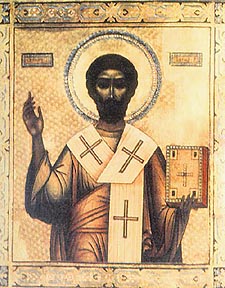 On June 11 the Church remembers two of the Holy Apostles. One is Bartholomew, and the other is Barnabas, companion of Saint Paul.
On June 11 the Church remembers two of the Holy Apostles. One is Bartholomew, and the other is Barnabas, companion of Saint Paul.
Barnabas was born in Cyprus into a Jewish family of the tribe of Levi. His birth name was Joseph. He was a friend and classmate of Saint Paul, then called Saul. They both studied under Gamaliel, the prominent rabbi and teacher of the Jewish Law. Joseph saw and heard Jesus Christ, and came to believe in Him as the Savior of the world. He would eventually be chosen as one of the original seventy apostles because of his great zeal for the Gospel.
We first read about Barnabas in Acts 4: 36. Those verses describe the sacrifice the early Christians made, selling their property and offering the proceeds to serve the needs of all. But only Joseph, “who was surnamed by the apostles Barnabas,” is specifically named, so he must have stood out. The name Barnabas means “son of encouragement” and it seems appropriate from the other things we know about him.
In Acts 9 we read about Saint Paul, now converted from a murderous enemy of the faith to a believer. He comes to Jerusalem, hoping to join the disciples. But “they were all afraid of him, for they did not believe that he was a disciple.” Again, Barnabas is named specifically, and is apparently the only one willing to give Paul a second chance. He convinces the others by telling them that “at Damascus he (Paul) had preached boldly in the name of the Lord” (9: 27).
Barnabas went to Antioch to observe the preaching to non-Jews in the community there. He was glad to see the grace of God working, and urged the people to “remain faithful to the Lord with steadfast purpose” (11: 23). Then he brought Paul from Tarsus to Antioch, where they taught a “large company” together for about a year. This is where we read that “in Antioch the disciples were for the first time called Christians.”
Kontakion – Tone 3
You became a true servant of the Lord and appeared as the first among the Seventy Apostles; together with Paul you set your preaching in a clear light revealing Christ as Savior to all; therefore with hymns we celebrate your godly memory, O Barnabas.
Paul and Barnabas continued their missionary work, accompanied by Barnabas’ relative John Mark. But when they got to Perga, John Mark left them to return to Jerusalem. Later, Paul suggested to Barnabas that they return to the cities where they had preached, to “see how they are” (15: 36). Barnabas, again giving someone a second chance, proposed that they take John Mark with them. But Paul refused because of the earlier desertion, and the two parted ways. They were later reconciled, and it seems likely that Barnabas’ kind nature was the key to healing the split.
On this same day we read Paul’s words in Romans 5: 10 about reconciliation: “For if while we were enemies we were reconciled to God by the death of His Son, much more, now that we are reconciled, shall we be saved by His life.” Paul must have been glad to have a partner like Barnabas, who always urged him toward reconciliation and the peace it brings.

